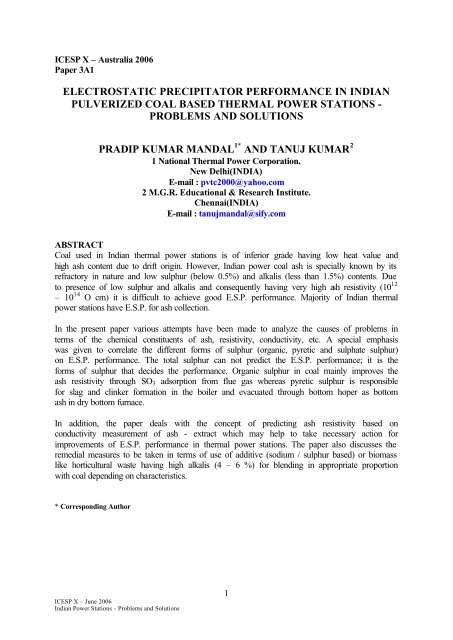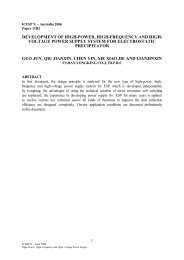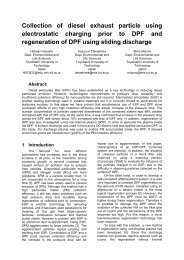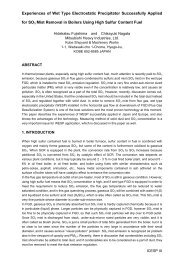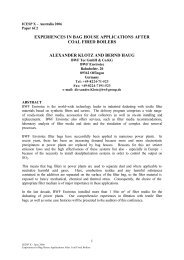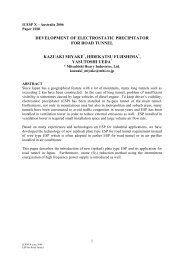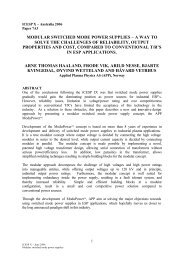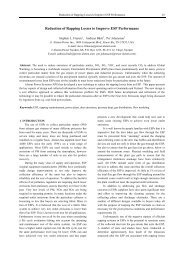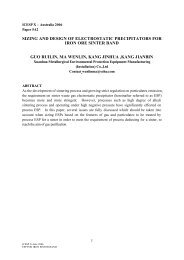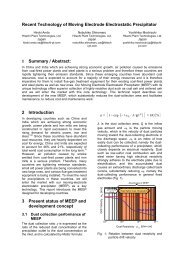Electrostatic precipitator performance in indian pulverized coal - isesp
Electrostatic precipitator performance in indian pulverized coal - isesp
Electrostatic precipitator performance in indian pulverized coal - isesp
You also want an ePaper? Increase the reach of your titles
YUMPU automatically turns print PDFs into web optimized ePapers that Google loves.
ICESP X – Australia 2006<br />
Paper 3A1<br />
ELECTROSTATIC PRECIPITATOR PERFORMANCE IN INDIAN<br />
PULVERIZED COAL BASED THERMAL POWER STATIONS -<br />
PROBLEMS AND SOLUTIONS<br />
PRADIP KUMAR MANDAL 1* AND TANUJ KUMAR 2<br />
1 National Thermal Power Corporation.<br />
New Delhi(INDIA)<br />
E-mail : pvtc2000@yahoo.com<br />
2 M.G.R. Educational & Research Institute.<br />
Chennai(INDIA)<br />
E-mail : tanujmandal@sify.com<br />
ABSTRACT<br />
Coal used <strong>in</strong> Indian thermal power stations is of <strong>in</strong>ferior grade hav<strong>in</strong>g low heat value and<br />
high ash content due to drift orig<strong>in</strong>. However, Indian power <strong>coal</strong> ash is specially known by its<br />
refractory <strong>in</strong> nature and low sulphur (below 0.5%) and alkalis (less than 1.5%) contents. Due<br />
to presence of low sulphur and alkalis and consequently hav<strong>in</strong>g very high ash resistivity (10 12<br />
– 10 14 O cm) it is difficult to achieve good E.S.P. <strong>performance</strong>. Majority of Indian thermal<br />
power stations have E.S.P. for ash collection.<br />
In the present paper various attempts have been made to analyze the causes of problems <strong>in</strong><br />
terms of the chemical constituents of ash, resistivity, conductivity, etc. A special emphasis<br />
was given to correlate the different forms of sulphur (organic, pyretic and sulphate sulphur)<br />
on E.S.P. <strong>performance</strong>. The total sulphur can not predict the E.S.P. <strong>performance</strong>; it is the<br />
forms of sulphur that decides the <strong>performance</strong>. Organic sulphur <strong>in</strong> <strong>coal</strong> ma<strong>in</strong>ly improves the<br />
ash resistivity through SO 3 adsorption from flue gas whereas pyretic sulphur is responsible<br />
for slag and cl<strong>in</strong>ker formation <strong>in</strong> the boiler and evacuated through bottom hoper as bottom<br />
ash <strong>in</strong> dry bottom furnace.<br />
In addition, the paper deals with the concept of predict<strong>in</strong>g ash resistivity based on<br />
conductivity measurement of ash - extract which may help to take necessary action for<br />
improvements of E.S.P. <strong>performance</strong> <strong>in</strong> thermal power stations. The paper also discusses the<br />
remedial measures to be taken <strong>in</strong> terms of use of additive (sodium / sulphur based) or biomass<br />
like horticultural waste hav<strong>in</strong>g high alkalis (4 – 6 %) for blend<strong>in</strong>g <strong>in</strong> appropriate proportion<br />
with <strong>coal</strong> depend<strong>in</strong>g on characteristics.<br />
* Correspond<strong>in</strong>g Author<br />
ICESP X – June 2006<br />
Indian Power Stations - Problems and Solutions<br />
1
INTRODUCTION<br />
Many countries around the world, <strong>in</strong>clud<strong>in</strong>g India, depend on <strong>coal</strong> and other fossil fuels to<br />
produce electricity. 65% of the total <strong>in</strong>stalled power generation is <strong>coal</strong>-based. 230 - 250<br />
million tones of <strong>coal</strong> are be<strong>in</strong>g used every year. Indian <strong>coal</strong> used <strong>in</strong> power stations is of<br />
<strong>in</strong>ferior grade hav<strong>in</strong>g high ash contents vary<strong>in</strong>g from 30 to 50%. The f<strong>in</strong>al result of burn<strong>in</strong>g<br />
of fossil fuels, particularly <strong>coal</strong>, is the emission of fly ash. Ash comes from m<strong>in</strong>eral matter<br />
present <strong>in</strong> the fuel (Raask, 1976). For a <strong>pulverized</strong> <strong>coal</strong> unit, nearly 80% of ash leaves with<br />
the flue gas. In India 95 million tones of ash generated every year. Ash generation is likely to<br />
reach 170 million tones by 2010. There are many techniques (Dalmon, 1980 and Potter,<br />
1978) to collect fly ash but electrostatic <strong>precipitator</strong> is the best. A <strong>precipitator</strong> is a relatively<br />
simple device( Fig.1)which separates particles from a gas stream by pass<strong>in</strong>g the carrier gas<br />
between pairs of electrodes across which a unidirectional, high – voltage potential is placed.<br />
The particles are charged before pass<strong>in</strong>g through the field and migrate to an oppositely<br />
charged electrode. It has collection efficiency of more than 99%, but does not work well for<br />
fly ash with a high electrical resistivity (as commonly results from combustion of low-sulfur<br />
<strong>coal</strong>).<br />
Figure 1: Top View of ESP Schematic Diagram [Source: Powerspan Corp.]<br />
The flue gas laden with fly ash is sent through pipes hav<strong>in</strong>g negatively charged plates which<br />
give the particles a negative charge. The particles are then routed past positively charged<br />
plates, or grounded plates, which attract the negatively-charged ash particles. The particles<br />
stick to the positive plates until they are collected. The air that leaves the plates is then clean<br />
from harmful pollutants (Fig 2.).<br />
Figure 2: Side view of ESP Schematic Diagram [Source: Powerspan Corp.].<br />
<strong>Electrostatic</strong> <strong>precipitator</strong>s can achieve over 99% clean<strong>in</strong>g efficiency (White 1963). However,<br />
this depends on many factors. Indian <strong>coal</strong>s used <strong>in</strong> power sectors, <strong>in</strong> general, produce ash that<br />
can be very difficult to precipitate. This <strong>coal</strong> has approximately 35 – 50% ash, which is<br />
comprised of 60 - 70% quartz. This makes the ash quite difficult to collect efficiently. Results<br />
ICESP X – June 2006<br />
Indian Power Stations - Problems and Solutions<br />
2
obta<strong>in</strong>ed by Bickelhaupt(1975)suggested one major factor <strong>in</strong> <strong>precipitator</strong> efficiency is the<br />
chemical composition of the gas and particulates. The precipitation of difficult ash was<br />
studied <strong>in</strong> details by Lowe, Dalmon and Hignett ( 1965).<br />
STUDY OF INDIAN POWER COAL TO VISUALIZE THE ESP PERFORMANCE<br />
To see the impact of Indian power <strong>coal</strong> on collection of ash by ESP some experiments were<br />
carried out us<strong>in</strong>g Indian non-cok<strong>in</strong>g <strong>coal</strong>s collected from seven different sources spread all<br />
over India.<br />
EXPERIMENTAL<br />
Material<br />
Seven <strong>coal</strong> samples (<strong>coal</strong> - a to <strong>coal</strong> - g) were collected from different <strong>coal</strong> sources used <strong>in</strong><br />
different <strong>coal</strong> based thermal power stations <strong>in</strong> India.<br />
Sample Preparation<br />
Test samples were prepared by con<strong>in</strong>g, quarter<strong>in</strong>g and gr<strong>in</strong>d<strong>in</strong>g to pass through 75 µm sieve.<br />
Proximate analysis, gross calorific value and total and different forms of sulphur content were<br />
determ<strong>in</strong>ed by standard procedures: IS 1350, part - I, ASTM D 3286, ASTM D3177 &<br />
ASTM D 2492 respectively.<br />
Ash Analysis (Coal Ash & Fly ash)<br />
To see the effect of ash<strong>in</strong>g temperature on conductivity and resistivity <strong>coal</strong> ash samples were<br />
prepared at various temperatures (400°, 600° & 1000°C) <strong>in</strong> the muffle furnace to control<br />
m<strong>in</strong>imum loss of sulphur due to heat<strong>in</strong>g. Fly ash samples were collected from ESP hoppers<br />
(rows 1-5) <strong>in</strong> dry form. Ash samples collected from different rows were mixed together to<br />
make it a representative one. The chemical analysis of ash was carried out by atomic<br />
absorption spectrophotometer.<br />
Determ<strong>in</strong>ation of Conductivity and Resistivity<br />
Sample Preparation<br />
Powered <strong>coal</strong> samples (pass<strong>in</strong>g through 200 # mesh, 75 µm) were kept <strong>in</strong> a well ventilated<br />
furnace at 400°, 600° and 1000°C for 30, 8 & 2 hrs respectively for preparation of ash<br />
samples for determ<strong>in</strong>ation of conductivity and resistivity of ash.<br />
Conductivity<br />
5.0 gm of <strong>coal</strong> ash (400°, 600° and 1000° C) and fly ash samples were refluxed <strong>in</strong><br />
conductivity water till complete leach<strong>in</strong>g (~ 2½ hrs). The leached solution was cooled to<br />
room temperature and filtered through Whatman No. 42 filter paper. The volume of filtered<br />
solution was made up to 100 ml with conductivity water. The conductivity was measured by<br />
conductivity meter.<br />
Resistivity<br />
For determ<strong>in</strong>ation of resistivity all the samples were s<strong>in</strong>tered at 300° C before press<strong>in</strong>g them<br />
<strong>in</strong>to pellets (~1.0 cm <strong>in</strong> diameter and 2.0 mm <strong>in</strong> thickness) <strong>in</strong> batches. The pre-s<strong>in</strong>tered<br />
samples were then pressed <strong>in</strong>to pellets with 10% poly v<strong>in</strong>yl alcohol b<strong>in</strong>der <strong>in</strong> Vanjax<br />
hydraulic press. The samples were aga<strong>in</strong> s<strong>in</strong>tered to about 350°C for 6 hrs to remove the<br />
b<strong>in</strong>der. On these s<strong>in</strong>tered pellets electrodes were prepared by silver paste on both the sides.<br />
Its DC resistivity was measured. The DC resistivity measurements were carried out us<strong>in</strong>g<br />
two- proves methods. The measurement set up was calibrated with the standard alum<strong>in</strong>um<br />
sample. The measurement error was about ± 2.0 %. The sample to be measured is loaded <strong>in</strong><br />
ICESP X – June 2006<br />
Indian Power Stations - Problems and Solutions<br />
3
the sample holder. A known voltage is applied to the sample. The correspond<strong>in</strong>g current was<br />
measured us<strong>in</strong>g nanometer for each voltage applied. From these quantities and dimension of<br />
the samples the resistivity were calculated. The measurements were carried out three times at<br />
room temperature at different tim<strong>in</strong>gs. The sample holder was kept <strong>in</strong> the temperature<br />
controlled oven at 200°C for the DC resistivity measurements to see the temperature effect.<br />
Other techniques of predict<strong>in</strong>g fly ash resistivity were suggested by Bickelhaupt(1979) and<br />
Tidy(1986).<br />
Additive<br />
Preparation of Samples to Study the Effect of Additive on Resistivity<br />
Nearly 50.0 gm of <strong>pulverized</strong> <strong>coal</strong> samples (- 200 # mesh, 75 µm) were treated with<br />
appropriate quantities of additive under study and blended thoroughly for homogeneous<br />
mix<strong>in</strong>g. The mixture was then burned <strong>in</strong> the furnace at 600°C for 2 hrs and resistivity was<br />
measured of <strong>in</strong>dividual mixture.<br />
RESULTS & DISCUSSION<br />
Nature of Coal Properties on Ash Resistivity/Conductance<br />
Proximate Parameters<br />
The Proximate analysis data and GCV of <strong>coal</strong> samples are given <strong>in</strong> Table 1.<br />
Table 1: The Proximate analysis data and GCV of <strong>coal</strong> samples (air dry basis)<br />
__________________________________________________<br />
Sample Station Proximate data (wt%) GCV<br />
Moistue Ash V.M. FC (kCal/kg)<br />
__________________________________________________<br />
Coal -a A 5.0 19.0 31.0 45.0 5070<br />
Coal- b B 2.1 24.0 34.0 40.0 5353<br />
Coal-c C 2.7 39.0 24.5 33.5 4200<br />
Coal-d D 4.1 42.8 25.5 27.6 3800<br />
Coal-e E 3.8 44.4 23.0 28.5 3650<br />
Coal-f F 3.6 47.4 21.00 28.0 3060<br />
Coal-g G 5.5 45.7 26.0 22.7 3330<br />
___________________________________________________<br />
The data reveals that the <strong>coal</strong>s ( Coal–a to Coal–g) used <strong>in</strong> various stations under study are of<br />
poor grade hav<strong>in</strong>g low heat value ( 3060 - 4200 kCal/kg) and high ash content ( 39 – 45 %)<br />
except <strong>in</strong> two stations ( station – A & station – B) where the ash is low (19 & 24 %) and GCV<br />
is high ( 5070 - 5353 kCal/kg).The high ash and low heat value <strong>coal</strong> demand high <strong>coal</strong><br />
feed<strong>in</strong>g <strong>in</strong> the furnace generat<strong>in</strong>g high fly ash consequently high load<strong>in</strong>g on ESP. As such the<br />
proximate data (especially V.M., FC & GCV) have no direct effect on ash resistivity and<br />
conductivity. However, the presence of moisture (Johnson, 1996), nature of chemical<br />
composition of ash (Harkar and Pimkarkar, 1988) and temperature have effect on ash<br />
resistivty. The effect of temperature on ash resistivity was studied <strong>in</strong> details by Cumm<strong>in</strong>g<br />
(1980). The effects of humidity, temperature and chemical composition of ash on ash<br />
resistivity are given <strong>in</strong> Fig.3 & Fig.4.<br />
ICESP X – June 2006<br />
Indian Power Stations - Problems and Solutions<br />
4
Figure3 : The effect of Humidity( moisture) on resistivity<br />
Figure 4: The effect of temperature on resistivity of different types of <strong>coal</strong>s of vary<strong>in</strong>g<br />
chemical compositions<br />
M<strong>in</strong>eral Matter / Ash Constituents<br />
The presence of m<strong>in</strong>eral matter and different ash constituents has an effect on ash resistivity<br />
and conductance. Indian non-cok<strong>in</strong>g <strong>coal</strong>s are rich of a-quartz (10 -20%) and kaol<strong>in</strong>ite (60 –<br />
70%). The various m<strong>in</strong>erals present <strong>in</strong> Indian <strong>coal</strong> are given <strong>in</strong> Table 2 and the ash<br />
composition of <strong>coal</strong> ashes are given <strong>in</strong> Table 3.<br />
Table 2: M<strong>in</strong>eral present <strong>in</strong> Indian <strong>coal</strong> (non-cok<strong>in</strong>g)<br />
____________________________________________________________________<br />
Sample<br />
Phases present<br />
Most predom<strong>in</strong>ant Predom<strong>in</strong>ant Small amount<br />
____________________________________________________________________<br />
Indian <strong>coal</strong> a-Quartz, Kaol<strong>in</strong>ite Hematite, Siderite, Rutile Pyrite, Gypsum<br />
____________________________________________________________________<br />
The resistivity of the flue gas borne ash <strong>in</strong> <strong>coal</strong> fired boilers generally varies from 10 4 – 10 14<br />
ohm cm. The <strong>pulverized</strong> ash after pass<strong>in</strong>g through the boiler flame consists of silicates,<br />
silicon dioxide, iron oxide, sulphate, alkal<strong>in</strong>e earth metal oxides, alkali metal oxides and<br />
unburned carbon. All these compounds have some effects on ressitivity of ash and ultimately<br />
the <strong>performance</strong> of ESP. The resistivity decreases with <strong>in</strong>crease of some elements like<br />
sulphur, alkalies, alkal<strong>in</strong>e earths and iron contents. A high silica and alum<strong>in</strong>a rich ash are<br />
high resistivity ash and reduces the ESP <strong>performance</strong>. Indian power <strong>coal</strong> generally conta<strong>in</strong>s<br />
ICESP X – June 2006<br />
Indian Power Stations - Problems and Solutions<br />
5
very high silica of the order of 55 – 65 % and alumia of the order of 25 – 35 %. The silica<br />
present <strong>in</strong> the <strong>coal</strong> is <strong>in</strong> the form of a- quartz and alum<strong>in</strong>a <strong>in</strong> the form of kaol<strong>in</strong>ite. The iron<br />
Table 3: The Chemical composition of ash samples<br />
_________________________________________________________________<br />
Sample Ash<strong>in</strong>g Parameter( wt%)<br />
Temperature(ºC) SiO 2 Al 2 O 3 Fe 2 O 3 CaO MgO Na 2 O K 2 O S<br />
_______________________________________________________________________<br />
Coal - a 600 61.7 25.6 4.5 1.6 1.2 0.1 0.6 0.4<br />
Coal - b 600 58.7 22.4 3.8 3.8 3.4 0.1 1.0 0.7<br />
Coal - c 600 63.2 25.2 4.7 1.5 0.8 0.1 0.8 0.6<br />
Coal - d 600 60.6 27.5 3.9 1.7 1.2 0.1 0.5 0.7<br />
Coal - e 600 58.5 28.3 5.6 1.4 1.0 0.1 0.8 0.6<br />
Coal - f 600 58.8 26.9 6.2 1.7 0.9 0.1 0.7 0.4<br />
Coal - g 600 58. 8 23.6 9.9 1.0 1.0 0.1 1.0 0.4<br />
Fly ash - 62.0 24.6 4.7 3.8 1.4 0.1 1.3 -<br />
Fly ash - 55.4 33.0 4.9 3.0 1.0 0.1 1.0 -<br />
_______________________________________________________________________<br />
present <strong>in</strong> the order of 4 – 12 % is <strong>in</strong> the form of hematite, siderite and pyrite. These m<strong>in</strong>erals<br />
have the effect on ash resistivity and also dictate the selection of suitable additive(s) for ash<br />
condition<strong>in</strong>g to reduce the resistivity of ash to make it favourable for ash collection by ESP.<br />
The values of resistivity and conductance of different ash samples used <strong>in</strong> the study are given<br />
<strong>in</strong> Table 4.<br />
Table 4: The values of resistivity and conductance of different ash samples<br />
(400°, 600°&1000 °C) at different temperatures.<br />
___________________________________________________________________________<br />
___Sample Resistivity x 10 12 (ohm cm) Conductance Temperature of<br />
Temperature of Experiment (°C) µS / cm ash<strong>in</strong>g (°C)<br />
Room 200°C<br />
Coal-a 1.7 - 566 600<br />
Coal-b 0.5 0.2 1507 600<br />
Coal-c 4.9 3.1 267 600<br />
Coal-d 1.3 - 688 600<br />
Coal-e 0.2 - 805 400<br />
1.0 - 574 600<br />
5.2 - 95 1000<br />
Coal-f 0.7 - 577 600<br />
Coal-g 0.8 2.7 - 600<br />
-------------------------------------------------------------------------------------------------<br />
Fly ash<br />
Station - B 6.5 2.0 - -<br />
Station - C 7.7 2.3 - -<br />
Station - D 8.6 2.6 - -<br />
Station - G 1.8 - - -<br />
________________________________________________________________________________________<br />
ICESP X – June 2006<br />
Indian Power Stations - Problems and Solutions<br />
6
Effect of Sulphur Content <strong>in</strong> Coal on Fly Ash Resistivity<br />
The major contribution of ash resistivity depends on the content of sulphur <strong>in</strong> <strong>coal</strong><br />
(Bickelhaupt, 1978). It was observed that resistivity / conductance of ash ma<strong>in</strong>ly depends on<br />
the follow<strong>in</strong>g factors:<br />
i) Forms of sulphur (organic, pyretic & sulphate sulphur)<br />
ii) Organic sulphur has more potential to reduce ash resistuvity than pyretic or sulphate<br />
sulphur <strong>in</strong> the <strong>pulverized</strong> <strong>coal</strong> fired boiler.<br />
iii) Availability of SO 3 <strong>in</strong> flue gas rather than sulphur content <strong>in</strong> <strong>coal</strong>.<br />
iv) Rate of conversion of SO 2 to SO 3 .<br />
v) Presence of other SO 3 absorb<strong>in</strong>g chemicals like alkalis and calcium content <strong>in</strong> fly ash.<br />
The orig<strong>in</strong> of three forms of sulphur <strong>in</strong> <strong>coal</strong> is available <strong>in</strong> the literature<br />
(Mandal,2003).Dur<strong>in</strong>g burn<strong>in</strong>g of <strong>pulverized</strong> <strong>coal</strong> <strong>in</strong> the furnace the organic sulphur present<br />
<strong>in</strong> <strong>coal</strong> gets evolved at higher temperature and generally burns at upper layer of the furnace<br />
and get entry <strong>in</strong>to flue gas. On the other hand, sulphur present <strong>in</strong> m<strong>in</strong>eral part of <strong>coal</strong> (e.g.<br />
pyritic, FeS2 and sulphate sulphur, CaSO 4 .2H 2 O) decompose at early stage of combustion at<br />
relatively lower temperature which is further lowered at reduc<strong>in</strong>g atmosphere and get entry<br />
<strong>in</strong>to the bottom part of the furnace. Coal used <strong>in</strong> the present study is of low sulphur <strong>coal</strong> and<br />
major share comes from organic sulphur <strong>in</strong> total sulphur content. The total and different<br />
forms of sulphur <strong>in</strong> <strong>coal</strong>s<br />
(Coal - a to Coal - g) are given <strong>in</strong> Table 5.<br />
Table 5: Total sulphur and different forms sulphur (wt%, air dry basis).<br />
___________________________________________________________________<br />
Sample Total Sulphur Pyritic Sulphur Sulphate Sulphur Organic Sulphur<br />
___________________________________________________________________<br />
Coal-a 0.39 0.070 0.004 0.316<br />
Coal-b 0.73 0.110 0.038 0.600<br />
Coal-c 0.63 0.094 0.013 0.523<br />
Coal-d 0.68 0.051 0.012 0.617<br />
Coal-e 0.58 0.080 0.009 0.491<br />
Coal-f 0.42 0.082 0.019 0.319<br />
Coal-g 0.36 0.120 0.040 0.200<br />
___________________________________________________________________<br />
By comparison of Data of Table 2, Table 3 & Table 4 it was observed that the resistivity<br />
values varied accord<strong>in</strong>g to the values of sulphur content especially organic sulphur.<br />
REMEDIAL MEASURES<br />
The <strong>coal</strong>s used <strong>in</strong> Indian power stations are generally non-cok<strong>in</strong>g low sulphur and alkali<br />
content <strong>coal</strong>s. The total silica and alum<strong>in</strong>a content is more than 90% mak<strong>in</strong>g the ash high<br />
resistivity ash. The problem become many fold due to low heat value and high ash <strong>coal</strong> which<br />
demand higher <strong>coal</strong> feed<strong>in</strong>g and result<strong>in</strong>g very high ash load<strong>in</strong>g on ESP. Another source of<br />
problems is <strong>in</strong> design<strong>in</strong>g of PC f<strong>in</strong>eness which is not as per <strong>coal</strong> reactivity and not<br />
ma<strong>in</strong>ta<strong>in</strong><strong>in</strong>g the f<strong>in</strong>eness level <strong>in</strong> many power stations lead<strong>in</strong>g to very f<strong>in</strong>e PC and get entry <strong>in</strong><br />
the furnace with generation of sub-size ash particles. In some of the stations it was found that<br />
more than 35% of ash particles are below 10 µm. F<strong>in</strong>eness has tremendous effect on ESP<br />
<strong>performance</strong>. The effect of f<strong>in</strong>eness on ESP ash collection is given <strong>in</strong> Fig. 5.<br />
ICESP X – June 2006<br />
Indian Power Stations - Problems and Solutions<br />
7
Figure 5: Effect of particle size on collection efficiency<br />
Improvement of electrostatic <strong>precipitator</strong> <strong>performance</strong> was suggested by Parker (1976) and<br />
Schrader (1970). The study on Indian non-cok<strong>in</strong>g <strong>coal</strong>s for possible improvement <strong>in</strong> ESP<br />
collection efficiency by means of optimization of various operat<strong>in</strong>g parameters like gas flow,<br />
temperature, size, etc <strong>in</strong> ESP systems or by up gradation of <strong>coal</strong> quality <strong>in</strong> terms of sulphur<br />
and alkali content, PC f<strong>in</strong>eness, etc are not sufficiently available. So to assign various steps<br />
for remedial measures for Indian power <strong>coal</strong> is very difficult. However, the follow<strong>in</strong>g<br />
possible remedial measures can be adopted to improve the ESP <strong>performance</strong> of Indian high<br />
resistivity ash:<br />
i) Operat<strong>in</strong>g gas temperature control<br />
ii) Intermittent energization<br />
iii) Wide – pitch electrodes<br />
iv) Pulsed power supply or semi pulsed operation<br />
v) Codition<strong>in</strong>g of flue gas ( ammona, ammonium sulphate , sodium carbonate, SO 3 ,<br />
sodium condition<strong>in</strong>g by sodium sulphate, etc).<br />
vi) To change <strong>coal</strong> properties by blend<strong>in</strong>g with high sulphur and high heat value <strong>coal</strong>. For<br />
example, north east <strong>coal</strong>s (S, 5-6%) or biomass like horticultural waste hav<strong>in</strong>g high<br />
alkalis ( 4 – 6 %) or mustered cropes waste (high sulphur content) may be blended<br />
with <strong>coal</strong> <strong>in</strong> appropriate proportion depend<strong>in</strong>g on the sulphur / alkali content. Ash<br />
collection efficiency of <strong>Electrostatic</strong> Precipitator (ESP) varies greatly accord<strong>in</strong>g to the<br />
electrical resistivity of the collected ash( Fig. 6).<br />
Figure 6: The effect of resistivity on ash precipitation rate.<br />
ICESP X – June 2006<br />
Indian Power Stations - Problems and Solutions<br />
8
Additive for improv<strong>in</strong>g the <strong>performance</strong> of electrical <strong>precipitator</strong>s<br />
Extensive research work has been carried out to reduce the resistivity of ash to improve the<br />
ash collection efficiency of ESP (Raask, 1976). The comparison of various chemical<br />
additives was studied <strong>in</strong> details by Dalmon and Tidy (1972).<br />
The effect of various additives on ash resistivity is given <strong>in</strong> Fig.7 & Fig. 8.<br />
Figure 7: The effect of different additives on ash resistivity<br />
Figure 8: The effect of additives on ash precipitation efficiency.<br />
The resistivity of <strong>coal</strong> is changed with many additives but they have some long term effect on<br />
metal. Especially the dos<strong>in</strong>g of SO 3 , Na 2 SO 4 , NaCl, etc is worth mention<strong>in</strong>g. The addition of<br />
carbonate (Na 2 CO 3 ) is preferable to that of sulphate or chloride. The effect of Na 2 CO 3 dos<strong>in</strong>g<br />
on resistivity is shown <strong>in</strong> Fig.9.<br />
The experience with additives to improve the <strong>performance</strong> of ESP can be summarized as<br />
follows:<br />
i) Trace amount of acidic and alkal<strong>in</strong>e additives when adsorbed on the surface of ash<br />
can reduce the resistivity by 2 – 3 orders of magnitude.<br />
ii) The most commonly used additive for this purpose is sulphur trioxide (SO 3 ). The<br />
additive may be <strong>in</strong>jected as neat SO 3 or generated from sulphuric acid or by<br />
catalytic oxidation of SO 2 .<br />
ICESP X – June 2006<br />
Indian Power Stations - Problems and Solutions<br />
9
iii)<br />
iv)<br />
Figure 9: The effect of Na 2 CO 3 on resistivity<br />
Solutions of ammonium sulphate and sulphamic acid are frequently used, which<br />
decompose to SO 3 and ammonia <strong>in</strong> the flue gas. Despite the higher cost, the<br />
solution additives are preferred because they are easily handled, but they may<br />
cause foul<strong>in</strong>g by sticky deposits.<br />
The effective dose rate of SO 3 <strong>in</strong> the flue gas depends on the ash composition and<br />
the sulphur content of <strong>coal</strong>, but is usually between 5 and 30 ppm. At these levels,<br />
SO 3 is quantitatively adsorbed by the flue gas borne ash and there should be no<br />
significant <strong>in</strong>crease <strong>in</strong> the SO 3 content of chimney emitted flue gas.<br />
v) Ammonia may be <strong>in</strong>jected directly <strong>in</strong>to the flue gas or it can be generated from<br />
thermal decomposition of sulphamic acid and triethyam<strong>in</strong>e. The effective dose<br />
rates were found to be between10 and 50 ppm NH 3 .<br />
vi)<br />
Solid additives are less extensively used as ash precipitation aids. The<br />
Experimental work has shown that alkali-metal compounds can be used with some<br />
low-sodium <strong>coal</strong>s. Iron compounds may also have some impact, but calcium<br />
compounds do not enhance ash precipitation. There are doubts that magnesium<br />
compounds can <strong>in</strong>crease the ESP <strong>performance</strong> with high resistivity ashes.<br />
Chang<strong>in</strong>g of Coal Ash Characteristics by Blend<strong>in</strong>g<br />
Detail survey on additive application reveals that there is no encourag<strong>in</strong>g acceptance of<br />
additive(s) dos<strong>in</strong>g by power station eng<strong>in</strong>eers, they place their trust <strong>in</strong> improv<strong>in</strong>g the<br />
eng<strong>in</strong>eer<strong>in</strong>g hardware rather than on chemical dos<strong>in</strong>g. In this situation, it is better to use<br />
blended <strong>coal</strong>s. The properties of <strong>coal</strong> required for better ESP <strong>performance</strong> can be changed by<br />
blend<strong>in</strong>g the poor grade <strong>coal</strong>s with higher grade <strong>coal</strong>, sometimes by imported <strong>coal</strong> or by<br />
biomass rich <strong>in</strong> alkali or sulphur content. This will provide the basis to change the resistivity of<br />
feed<strong>in</strong>g <strong>coal</strong>, <strong>in</strong> turn results <strong>in</strong> improvement of ESP <strong>performance</strong>. In India, <strong>coal</strong>s from North –<br />
Easter region content low ash and high Sulphur and hav<strong>in</strong>g high heat value. Biomass like<br />
horticulture wastes (mustered crop waste, cotton seeds, coffee husk, etc.) hav<strong>in</strong>g high alkali<br />
content can be used. Some trial has been made us<strong>in</strong>g Coal-a and high sulphur <strong>coal</strong> from North<br />
Eastern region (S=6%) <strong>in</strong> different ratio. The resistivity value of Coal – a was reduced to less<br />
than 10 12 ohm cm, <strong>in</strong> 90 :10 ratio(Coal-m) of Coal-a and north eastern <strong>coal</strong> of high S(6%), less<br />
than 10 11 ohm cm <strong>in</strong> 75:25 ratio(Coal-n) and less than 10 10 ohm cm <strong>in</strong> 55:45 ratio <strong>in</strong> blended<br />
<strong>coal</strong>(Coal-o). Blended <strong>coal</strong> with 55:45 ratio will be the most suitable <strong>coal</strong> <strong>in</strong> terms of good ESP<br />
<strong>performance</strong> is concern (Fig.10).<br />
ICESP X – June 2006<br />
Indian Power Stations - Problems and Solutions<br />
10
Figure 10: The effect of blended <strong>coal</strong> on resistivity<br />
Some Comments on ESP Performance <strong>in</strong> India due to Use of Low Grade Nn-cok<strong>in</strong>g<br />
Coals <strong>in</strong> Pulverized Coal Based Stations<br />
Based on the many years operat<strong>in</strong>g experiences <strong>in</strong> power stations <strong>in</strong> India it can be mentioned<br />
that for Indian power <strong>coal</strong>s the <strong>performance</strong> of the ESP is <strong>in</strong>fluenced by many factors and <strong>in</strong><br />
practical sense to achieve the 99.9 % efficiency is very difficult. It may achieve the target but<br />
the susta<strong>in</strong>ability is very less. After overhaul<strong>in</strong>g the ESP system works very satisfactorily but<br />
it deteriorates its <strong>performance</strong> very rapidly. This is because of the high refractory nature of<br />
ash and poor heat value of Indian non-cok<strong>in</strong>g <strong>coal</strong> result<strong>in</strong>g <strong>in</strong> over load<strong>in</strong>g on ESP system.<br />
i) Clear<strong>in</strong>g of electrodes: - The <strong>performance</strong> of ESP generally depends on the amount of<br />
electrical power consumed by the system. The highest collection efficiency is<br />
achieved when maximum possible electrical power for a given set of operat<strong>in</strong>g<br />
conditions is utilized <strong>in</strong> the precipitation process. Dur<strong>in</strong>g the operation of ESP, the<br />
applied is reduced by the potential drop across the deposited dust layer on the<br />
collect<strong>in</strong>g electrodes due to current flow<strong>in</strong>g through it. This results <strong>in</strong> the reduction of<br />
the effective voltage which consequently reduces the efficiency. A thick cover of dust<br />
layer on the collect<strong>in</strong>g electrode also leads to unstable operat<strong>in</strong>g conditions. The ash<br />
deposit on the emitt<strong>in</strong>g wires results <strong>in</strong> non-uniform corona. So the efficiency<br />
decreases due to heavy deposits of ash on collect<strong>in</strong>g and emitt<strong>in</strong>g electrodes which<br />
needs efficient rapp<strong>in</strong>g system for both the collect<strong>in</strong>g and emitt<strong>in</strong>g electrodes.<br />
ii) Gas temperatures: - The operation of <strong>precipitator</strong> at gas temperature below the<br />
a. acid due po<strong>in</strong>t ( < 100°C) results <strong>in</strong> :<br />
b. Failure of emitt<strong>in</strong>g electrodes due to stress corrosion crack<strong>in</strong>g.<br />
c. Corrosion of term<strong>in</strong>als.<br />
d. Collection of wet ash on the electrodes leads to formation of hard- to- rap<br />
layers of ash.<br />
e. Difficulty <strong>in</strong> removal of wet ash from the hoppers.<br />
iii) Spark rate: - The operat<strong>in</strong>g voltage and current keep chang<strong>in</strong>g with operat<strong>in</strong>g<br />
conditions. This takes care by the electronic controller unit. Very high flash over rate<br />
results not only reduction of useful power and <strong>in</strong>terruption of precipitation process but<br />
also cause snapp<strong>in</strong>g of emitt<strong>in</strong>g electrodes due to electrical erosion.<br />
ICESP X – June 2006<br />
Indian Power Stations - Problems and Solutions<br />
11
iv) Rapp<strong>in</strong>g frequency: - The frequency and sequence of rapp<strong>in</strong>g of collect<strong>in</strong>g and<br />
emitt<strong>in</strong>g electrodes are programmed by the synchronous program master controller.<br />
The time <strong>in</strong>terval between the raps of various fields have been optimally chosen to<br />
permit build- up of sufficiently thick layer so that when rapped , the ash is dislodged<br />
<strong>in</strong> the form of agglomerates result<strong>in</strong>g <strong>in</strong> re-entra<strong>in</strong>ment and puffs through the stack.<br />
v) Oil combustion: - The unburned oil has an important impact on ESP <strong>performance</strong>.<br />
Unburned oil, if pass through EP, can clot the collect<strong>in</strong>g and emitt<strong>in</strong>g electrodes. This<br />
reduces the <strong>precipitator</strong> operat<strong>in</strong>g voltage due to high electrical resistivity and<br />
consequently the EP <strong>performance</strong>s deteriorate. The <strong>precipitator</strong> <strong>performance</strong> rema<strong>in</strong>s<br />
poor until the oil vaporizes and the layer get rapped off., which is usually takes few<br />
weeks time.<br />
vi) Hopper evacuation: - Improper / <strong>in</strong>complete hopper evacuation is the major cause for<br />
the ESP malfunction<strong>in</strong>g. If the hoppers are emptied regularly the ash will build to the<br />
high tension emitt<strong>in</strong>g system caus<strong>in</strong>g shorts. In addition, the ash build up <strong>in</strong> the ESP<br />
chamber beyond the hopper will cause bulk<strong>in</strong>g of the collect<strong>in</strong>g plates and<br />
dissociation of the emitt<strong>in</strong>g frames lead<strong>in</strong>g to misalignment of the electrodes.<br />
CONCLUSION<br />
Indian non-cok<strong>in</strong>g <strong>coal</strong>s used <strong>in</strong> power stations are of poor grade hav<strong>in</strong>g high ash ( 35 – 50%)<br />
and low heat value( 2500 – 5000 kCal /kg). The ash conta<strong>in</strong>s ma<strong>in</strong>ly silica and alum<strong>in</strong>a (total,<br />
> 90 %). Fly ashes are of low Sulphur ( < 0.5%) and low alkalis(
Bickelhaupt R.E. (1979). A technique for predict<strong>in</strong>g fly ash resistivity, EPA Report, 600/7-79/204.<br />
Bickelhaupt R.E. (1978). Flue gas condition<strong>in</strong>g for enhanced precipitation of difficult ashes, EPRI<br />
Report FP-910.<br />
Cumm<strong>in</strong>g J.W. (1980). The electrical resistance of <strong>coal</strong> ash at elevated temperatures, Jour. Inst.<br />
Energy, 53, 153, 1980.<br />
Dalmon J. (1980). <strong>Electrostatic</strong> <strong>precipitator</strong>s for large power station boile,. Jour.<strong>Electrostatic</strong>s, 8, 309,<br />
1980.<br />
Dalmon J. and Tidy D. (1972). A comparison of chemical additives as aids to the electrostatic<br />
precipitation of fly ash, Atmos. Envir., 6 , 721, 1972.<br />
Johnson M. (1996). The effect of humidity on the <strong>performance</strong> of electrosatatic <strong>precipitator</strong>s at<br />
Tarong Power Station, BE Thesis , Queensland University of Technology, Brisbane, 1996.<br />
Harker J.R. and Pimkarkar P.M. (1988). The effect of additives on the electrostatic precipitation of flu<br />
ash, Jour.Inst. Engrr. pp 134 – 142, 1988.<br />
Lowe H.J., Dalmon J.and Hignett E.T. (1965). The precipitation of difficult dusts, IEE Colloq.<br />
<strong>Electrostatic</strong> Precipitators, London, 1965.<br />
Mandal P.K.and Banerjee.D.(2003). Effect of different forms of sulphur <strong>in</strong> <strong>coal</strong> on ESP <strong>performance</strong>,<br />
9, 71-77, 2003.<br />
Potter E.C(1978). <strong>Electrostatic</strong> Precipitation Technology, A Different Viewpo<strong>in</strong>t, Jour. Air Poll.<br />
Contr. Assoc., 28, pp 40-46, 1978.<br />
Parker(1996). Improv<strong>in</strong>g <strong>Electrostatic</strong> Precipitator Performance for power Stations, Power<br />
Eng<strong>in</strong>eer<strong>in</strong>g Journal, 169-176, 1996.<br />
Raask E.(1976). Resistivity of particulate <strong>coal</strong> m<strong>in</strong>erals, Jour. Inst. Fuel, 45, 201, 1972.<br />
Schrader K.(1970). Improvement of the efficiency of electrostatic precipitation by <strong>in</strong>ject<strong>in</strong>g SO 3 <strong>in</strong>to<br />
the flue gas, Combustion, 42, 22, 1970.<br />
Tidy D.(1986). Measurement of resistivity relevant to the electrostatic precipitation of <strong>pulverized</strong> fuel<br />
ash, Journal of the Institute of Energy, pp 70 – 76, 1986.<br />
White H.J. (1963). Industrial <strong>Electrostatic</strong> Precipitation, Oxford : Pergamon, 1963.<br />
ICESP X – June 2006<br />
Indian Power Stations - Problems and Solutions<br />
13


